Wayanad Wildlife Sanctaury
Wayanad Wildlife Sanctuary, located in the Wayanad district of Kerala, India, is a significant biodiversity hotspot in the Western Ghats region. It was established in 1973 and is now part of the larger Nilgiri Biosphere Reserve. The sanctuary spans over 344 square kilometers and is home to diverse flora and fauna.
The sanctuary is characterized by its lush greenery, dense forests, and rugged terrain, making it an ideal habitat for various wildlife species. Some of the animals found here include elephants, tigers, leopards, Indian bison (gaur), deer species like sambar and spotted deer, langurs, macaques, and a wide variety of bird species.
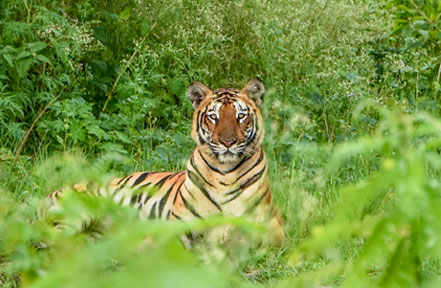
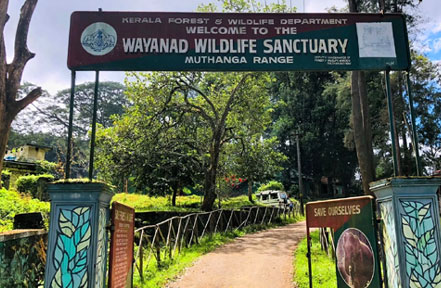
History and General Info
The history of Wayanad Wildlife Sanctuary dates back to its establishment in 1973. The sanctuary was created primarily to protect the rich biodiversity of the Wayanad region, which is nestled in the Western Ghats of Kerala, India. This area is known for its unique ecosystem and high levels of species endemism.
Initially, the sanctuary covered a smaller area, but over time, it expanded to encompass a larger territory, eventually spanning over 344 square kilometers. This expansion was likely a response to the growing recognition of the need to conserve the diverse flora and fauna of the region.
Wayanad Wildlife Sanctuary's inclusion in the larger Nilgiri Biosphere Reserve further highlights its significance in regional conservation efforts. The Nilgiri Biosphere Reserve is one of the largest protected areas in India and is recognized internationally for its biodiversity and ecological importance.
The sanctuary's landscape is characterized by dense forests, hilly terrain, and lush greenery, providing a perfect habitat for a wide range of wildlife species. From large mammals like elephants, tigers, and leopards to smaller creatures like langurs, macaques, and various bird species, the sanctuary supports a diverse array of flora and fauna.
Over the years, the sanctuary has become not only a haven for wildlife but also a popular destination for eco-tourism and nature enthusiasts. Visitors have the opportunity to explore the sanctuary through guided safaris, trekking trails, and nature walks, providing an immersive experience in the heart of nature.
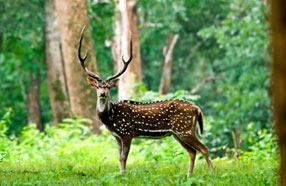
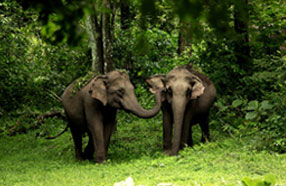
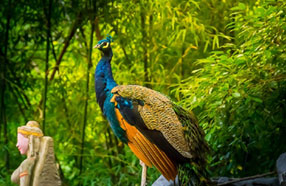
Topography and Climate of Wayanad wildlife sanctuary
The sanctuary is situated amidst the Western Ghats, known for its rugged and hilly landscape. The terrain varies from gentle slopes to steep hills and valleys.The sanctuary spans elevations ranging from around 700 meters to 2100 meters above sea level, leading to diverse habitats and microclimates. Within the sanctuary, you'll find deep valleys, high plateaus, and narrow ridges, each offering different ecological niches for various plant and animal species. Several rivers and streams flow through the sanctuary, providing water sources for the wildlife and contributing to the overall ecosystem's health.
Wayanad Wildlife Sanctuary experiences a tropical climate due to its location near the equator. The sanctuary receives heavy rainfall during the monsoon season, which typically lasts from June to September. This rainfall is vital for sustaining the lush greenery and supporting the diverse flora and fauna. The temperature in Wayanad remains moderate throughout the year, with average temperatures ranging from 20°C to 35°C. However, the higher elevations may experience cooler temperatures. The sanctuary experiences distinct seasons, including a hot and dry season from March to May, followed by the monsoon season, and then a cooler period from October to February. Given its tropical climate, humidity levels can be relatively high, especially during and after the monsoon season.
Tropical Semi-Evergreen Forests: These forests experience moderate to high rainfall and retain greenery throughout the year, although some tree species shed leaves seasonally. The flora in this type of forest includes a mix of evergreen and deciduous species. Some prominent species found in tropical semi-evergreen forests of Wayanad are:
Tropical Dry Forests: These forests experience a distinct dry season and receive less rainfall compared to other forest types. As a result, they are characterized by deciduous trees and shrubs adapted to drought conditions. Some notable flora found in tropical dry forests of Wayanad include:
Some Quick Facts About Wayanad wildlife sanctuary
Best Time to See Wayanad wildlife sanctuary
Winter (November to February): This period is considered the peak tourist season in Wayanad due to the pleasant weather with temperatures ranging from 10°C to 25°C. The cool and dry weather makes it an ideal time for wildlife safaris and trekking. During this time, you have a good chance of spotting various wildlife species as they are more active during the cooler parts of the day.
Monsoon (June to September): Wayanad receives heavy rainfall during the monsoon season, which rejuvenates the lush greenery of the sanctuary. While the rain can make outdoor activities challenging, it's an excellent time for nature enthusiasts and photographers interested in capturing the beauty of the rain-washed landscapes. However, wildlife sightings may be less frequent during this time as animals tend to take shelter during heavy rainfall.
Summer (March to May): The summer months in Wayanad are characterized by warm temperatures ranging from 20°C to 35°C. While it can get hot during the day, early mornings and late evenings are still relatively pleasant. Summer is a good time for birdwatching as many migratory bird species visit the sanctuary during this period. However, wildlife sightings might be less frequent during the hotter parts of the day as animals seek shade and waterholes.
Major Things to do in Things to do in Wayanad wildlife sanctuary
Wildlife Jungle Safari: Embark on a thrilling wildlife safari through the sanctuary to spot a variety of animals in their natural habitat. You can hire a jeep or opt for guided tours conducted by the forest department to explore the core areas of the sanctuary. Keep an eye out for elephants, tigers, leopards, deer, langurs, macaques, and numerous bird species.
Scenic Birdwatching: Wayanad is a paradise for birdwatchers with its rich avian diversity. Grab your binoculars and head out on birdwatching excursions to spot a wide range of resident and migratory bird species. Some common birds found in the sanctuary include peafowl, Malabar grey hornbill, jungle fowl, woodpeckers, and various species of kingfishers.
Boating: Enjoy a serene boating experience on the tranquil waters of Pookode Lake, which is located near the sanctuary. Surrounded by lush greenery and offering breathtaking views of the surrounding hills, Pookode Lake is an ideal spot for boating and picnicking.
Visit Tribal Villages: Gain insights into the indigenous tribal culture of Wayanad by visiting nearby tribal villages. Interact with the locals, learn about their traditional way of life, and purchase authentic handicrafts and souvenirs made by tribal artisans.
Stay in Eco-resorts: Experience sustainable tourism by staying in eco-friendly resorts or jungle lodges located in and around the sanctuary. These accommodations offer comfortable stays amidst nature while minimizing environmental impact.
Nature Photography: Capture the stunning landscapes, diverse wildlife, and vibrant birdlife of Wayanad Wildlife Sanctuary through photography. Whether you're an amateur enthusiast or a seasoned photographer, you'll find plenty of opportunities to capture memorable moments in this biodiverse sanctuary.
